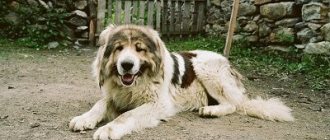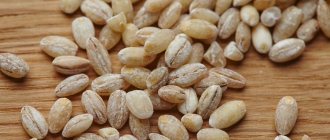Breed characteristics
Breed characteristics leave an imprint on raising puppies. The type of food depends on the size of the dog, its working qualities and many other aspects of physiology, purpose and lifestyle.
All dogs are genetically carnivores, but an active life and constant movement requires compensation for energy costs in the form of high-protein diets. Puppies grow disproportionately, and often the rapidly increasing body weight “puts pressure” on the fragile skeleton, as a result of which puppies begin to have problems with the musculoskeletal system.
Remember! It is not difficult to spoil a dog by turning it into a disabled person: physical activity that is inappropriate for its age and an unbalanced diet will quickly do their job.
Any type of nutrition requires a regimen, a competent approach to diet planning, and careful attention to your pet.
Feeding your puppy natural food
Natural food for dogs implies dishes made from high-quality and fresh ingredients from meat, cereals, vegetables and other ingredients. The products purchased for the owner and the dog may be similar, but the nutrition of the puppies is fundamentally different from what is on the owner’s table.
For the correct formation of posture and from the point of view of some aspects of health, the German Shepherd's feeding bowl is placed on a special stand.
Such “barbells” can be purchased at any pet store - they are very convenient because the level can be changed as the puppy grows. The bowl should be secured so that the puppy does not lower or lift his head too much. The second bowl is filled with water.
The diet for a puppy changes as it grows, both in quality and quantity, but the main list of food products is practically unchanged.
The components of the diet and their nutritional “value” are presented in the table.
| Product | Purpose | How to give |
| Meat (lean beef, veal, horse meat, rabbit) | The most valuable source of proteins, necessary for the construction and regeneration of cells, the production of necessary amino acids, the basis of life activity and the most important ingredient in a puppy’s diet. | Daily |
| Poultry (chicken, turkey, duck) | Easily digestible protein of animal origin, excellent calorie product | Daily |
| Fish (oceanic: salmon, cod, hake, perch) | A source of complete protein, calcium and polyunsaturated fats necessary for good heart and brain function | Once a week |
| Offal (liver, kidneys, heart, tripe, udder, lungs, ears and tails) | Excellent sources of protein, vitamins and minerals, fatty acids, and substances for joint elasticity and cartilage | Once a week |
| Eggs (chicken, duck, quail) | Sources of protein, fatty acids, vitamins and minerals | 1-2 times a week |
| Milk and fermented milk products (kefir, fermented baked milk, yogurt, cottage cheese, cheese) | Rich in calcium, protein, improve intestinal microflora | Daily |
| Cereals (rice, buckwheat, rolled oats) | Source of carbohydrates that carry energy and other nutrients | Daily |
| Vegetables, fruits and berries (zucchini, cucumber, carrots, tomato, pumpkin, turnip, celery, apple, pear, banana, melon, watermelon, gooseberry, blueberry) | Digestive fiber, sources of vitamins and minerals | Daily |
| Bones (cartilage, soft ribs, chicken heads) | They supply the body with special substances for the elasticity of joints (chondroprotectors), and also prevent caries and periodontitis. | 1-2 times a week |
| Vegetable oil (sunflower, olive, flaxseed), animal fats (beef, chicken), butter | An excellent source of energy, vitamins, unsaturated acids | Daily |
| Vitamin and mineral supplements | Ensure proper growth, organ development and healthy reproduction, good immunity and beautiful coat | Daily |
| Water | Drinking fresh water is an integral part of the diet | Around the clock |
German Shepherd puppies develop for quite a long time - sometimes the final physical and mental development ends by 3 years. However, the majority of puppies are considered adults when they reach one and a half years old. All this time, the feeding regime, the amount of food and its components are changing.
An important feeding rule, regardless of the puppy’s age: each new product is given in small doses and one at a time, after the body has “fixed” the work with the previous food. It is necessary to monitor the puppy: the mucous membranes, skin and stool require attention.
German shepherds are dogs with good health, however, illiterate breeding work and poor ecology have led to frequent allergic reactions to food in pets of many breeds.
Diet of a puppy at the age of 1 month
At such a young age, puppies, as a rule, are under their mother and are fed with her milk. The exception is an unpleasant situation with the death of a bitch or the early weaning of a puppy for one reason or another. In any case, 1 month is the age when it is time to give the dog its first complementary foods.
Products suitable for the first feeding, gradually forming the diet of a one-month-old puppy:
- Meat. Skoblyanka or minced meat is made from raw beef. The meat is first frozen and scalded with boiling water. Puppies readily eat meat porridge, and you should not overuse it on the first day - a teaspoon is enough.
- Porridge. Cook rice water in water, milk or weak broth. You can make porridge from oatmeal, but unlike other porridges, rolled oats are not boiled, but steamed. The flakes need to be ground in a blender and poured with hot milk or broth. A controversial issue is the use of semolina in dog diets. Modern zoo nutritionists are against this product, but semolina has long been used by breeders to gain weight in dogs, as well as to feed puppies up to a month old. If the baby is not allergic to gluten, semolina porridge can be given little by little.
- Cottage cheese. You can buy low-fat cottage cheese in the store or prepare it yourself: buy calcium chloride at the pharmacy and pour it into boiling milk (20 ml of calcium per 2 glasses of milk). As soon as the milk has curdled, place it in a colander. Whey can also be used in the diet. Another way to make cottage cheese is by curdling milk mixed with kefir.
- Eggs. For puppies, raw yolk is added to vegetables, porridge or meat. It is better to boil the protein or make an omelet from the egg.
- Soups and broths with cereals and vegetables. Broths are cooked with bones, lean meat or vegetables. They add vegetables, rice or rolled oats. Liquid food is not a priority for dogs, but is acceptable in early puppyhood.
- Vegetables (zucchini, carrots) are given little by little, stewed and pureed. From the 7th week of a puppy’s life, they can be rubbed raw into porridge or meat and seasoned with oil. Large pieces of carrot or apple are necessary for the puppy to stimulate the change of teeth and clean off plaque.
- Vitamins (A and D): sold in pet pharmacies. Give drop by drop in the morning and evening.
How to create a diet from natural products
Most breeders and owners prefer to feed their German Shepherd puppies a natural diet.
This menu is considered the closest to the natural diet of dogs.
The owner can personally control the quality of the products, their calorie content and diversify the menu every day.
But natural feeding at home takes a lot of time and effort. You will have to think through recipes and prepare dishes every day.
When eating “naturally”, the following proportions are observed:
- 60–70% should be protein foods: meat, offal, eggs, dairy products;
- 25 - 35% is allocated to products of plant origin - cereals, vegetables, fruits, berries, herbs;
- the remaining 5% includes additives - treats, vitamins, vegetable oils.
The daily diet is made up of several ingredients at the same time. There are a number of foods that can and cannot be fed to German puppies.
Meat
It is administered from the 2nd month of life. First they give you scraped meat, then chopped meat.
The size of the pieces is gradually increased, as is the serving size: from 50 g to 400 g from 8 to 16 weeks. By six months, meat should make up at least 30% of the total product volume.
It is best to feed raw meat, as it does not lose nutrients. Before serving, it is frozen for 3 days to avoid the risk of helminth infection.
The “German” is fed the same meat as all dogs:
- chicken;
- beef;
- rabbit meat;
- turkey.
It is forbidden to feed a German with fatty varieties:
- pork;
- lamb;
- goose;
- duck.
By-products
Second most important products. They are rich in beneficial vitamins and minerals, but cannot fully replace meat.
By-products are introduced from 4 months. At first they give it 2–3 times a week, then daily. These include:
- heart;
- liver;
- scar;
- lungs;
- kidneys;
- udder;
- spleen;
- brain;
- lips, ears and other trimmings.
They provide 1.5 times more by-products than meat. The exception is the heart. Its quantity should be less than a quarter of beef, chicken or turkey.
What foods should you not give to your German Shepherd puppy?
In order not to be subsequently tormented by remorse and not to spend crazy amounts of money on treating your dog, you should adhere to the rules of feeding and not give the puppy anything that is harmful to it.
What a puppy does not need at all:
- flour and sweet;
- pickles and smoking;
- sausages and canned food;
- chocolate (in large doses it is life-threatening);
- fat meat;
- boiled and tubular bones;
- Exotic fruits;
- boiled potatoes;
- River fish;
- food from the master's table, with spices and salt.
There are plenty of options for pampering your pet: puppies are given crackers (homemade), pieces of fruit, cheese and vegetables, and dry food granules. There are an incredible number of dog treats you can buy in stores, and they are all safe.
Reviews
Oleg Romanov, Nizhny Novgorod
“We have a 9 month old German/Eastern Shepherd mix. We always cooked porridge with meat for her, but in the summer season we move to the dacha and there is no such opportunity there anymore. Therefore, every season he switches to dry food. Problems with the gastrointestinal tract were usually not observed, and the color of the stool occasionally changed. It might be worth trying to make the transition more smoothly.”
Maria, Moscow
“I noticed that from the age of three months my German baby began to itch a lot. I fed her according to all the rules: chicken broth, rice, buckwheat, millet, wheat, beef, beef bones, minced dog, bread. But then she noticed that her mother-in-law occasionally tossed her sausage from the table, smoked meats, or pasta. We went to the vet and it turned out she had a food allergy! They prescribed a stricter diet and vitamin supplements to relieve intoxication. Now everything is fine, but I had an educational conversation with my mother-in-law on the topic of PP in German shepherds).”
Irina Alexandrova, Arkhangelskoye village
“This is what we feed our German Shepherd (5 months old):
In the morning, 350 grams of cottage cheese with kefir or yogurt. For lunch – 300 grams of rice, oatmeal or buckwheat porridge + 250 grams of beef + vegetables with a tablespoon of vegetable oil. Add vitamins in drops. In the evening for dinner everything is the same as for lunch, only without vitamins. We mix meat and vegetables, but put the porridge in a clean bowl so that it does not become saturated with the smell of other food. Dry food was never present in our diet. But we still use a lot of water because we have a private home and the dog spends a lot of time outdoors.”
Video
Before purchasing a pet, you should definitely find out what cereals can be given to dogs - German shepherds. Dogs of this breed demonstrate increased activity and require constant physical activity, so they need high-quality food that can provide them with the necessary energy and nutritional components.
Dogs are omnivores, so they benefit from both plant foods and meat. Thanks to this, you can feed your German Shepherd porridges based on various cereals, but you cannot cook everything in a row, since the pet will not be able to digest some of them. It is best to provide a mixed diet.
About the amount of food for a puppy and its proportions
There is endless debate about how much food to give a dog depending on its age. And this is justified, because all dogs have individual nutritional needs. The same food is digested differently even among littermates, due to different metabolisms, housing conditions, adherence to the schedule of vaccinations and deworming, and other reasons.
It is believed that 7% of a dog’s weight is the average daily food intake. These indicators are arbitrary: often, with the same weight, one dog can be very thin, a second can have excellent average weight gain, and a third can be obese.
It is very important for a puppy owner to learn to “see” his dog. Feel her mood, distinguish fatigue from the first symptoms of illness, observe her stool, the quality of her coat, be able to visually and by touch determine her fatness.
For any menu, the main factor is the ratio of nutrients: for any dog, the diet consists of 70% protein products (meat, fish, eggs, fermented milk and dairy products), 20% porridge, 10% vegetables.
Feeding a German Shepherd puppy with dry food
This method of feeding certainly frees up a lot of free time for dog breeders and owners. Having chosen a good brand of food, you don’t have to worry about missing some important components in your diet: high-end industrial diets are balanced in composition and do not require additional feeding.
All dry food is divided into classes:
- economy;
- premium;
- super premium;
- holistic
Economy
In the economy class food sector there is nothing useful for shepherds: this food is made from useless cereals that often cause allergic reactions in dogs, there is practically no high-quality protein, and its very quantity is at a level that does not allow raising a beautiful and healthy dog. For comparison, we can give the example of instant noodles: it is difficult to imagine how you can raise a healthy child with its help.
Examples of such nutrition are the diets Chappi, Darling, Our Brand and others. As a rule, the composition of such food “sounds” as follows: cereals and offal, meat ingredients, animal fat, vegetable oils, minerals and vitamins.
The sources of raw materials are not specified; the percentage of proteins and fats is extremely low. In addition, there are no diets for puppies in this segment.
Premium
In the premium dry food sector, you can find food for a dog on which it will not suffer from a lack of vital nutrients, provided that it is supplemented with meat and, in some cases, vitamins (combined nutrition will be discussed separately). These foods have a dedicated “puppies” line and even a breakdown by breed.
Feeding during pregnancy
If your dog is pregnant, you may need to review her diet. The diet should be balanced and proper, but a shepherd dog carrying puppies needs more phosphorus and calcium. For this reason, it is advisable to add more cheese and cottage cheese to your daily diet. Also, don’t forget about fish, which now needs to be given 2-3 times a week.
How many times a day should I feed my pregnant German Shepherd? At the beginning of pregnancy, we increase the number of meals to 3 times a day. Around the eighth week, the daily diet includes four meals a day. In the week before giving birth, the dog is fed 5-6 times a day.
In the second half of pregnancy, it is better to feed a shepherd dog fish rather than meat; you should also significantly increase the amount of vegetables and fruits consumed. If the period of gestation of puppies falls during the winter season, we additionally give the expectant mother vitamins A and D.
After birth, puppies are breastfed, therefore, the dog’s diet again needs to be reviewed. For the first few days after birth, exclude meat and fish; the animal should be fed fermented milk products. In the future, the diet of a nursing shepherd dog should contain various fortified complexes.
Mixed feeding of a German Shepherd puppy
Feeding puppies with both natural and dry food makes sense only when it is not possible to purchase a good dry diet and the owner does not have time to “cook”. And although the mixed method of feeding is undesirable, it is used quite often, exposing the dog to the risk of disruption in the functioning of the gastrointestinal tract.
For lovers of mixed feeding, the most optimal option would be to supplement the dog with meat if there are clear signs of protein deficiency in a puppy eating dry food. There are enough such signs, and even an inexperienced owner will understand that the dog is lethargic, gets tired quickly, has poorly growing claws and dull fur. Lack of protein leads to a decline in immunity and other problems.
It is strictly not recommended to mix complete natural nutrition with dry food: in case of health problems, it will be extremely difficult for the doctor to figure out what exactly caused the imbalance.
An overdose of vitamins, minerals and even protein is very dangerous for both shepherds and all dogs. Industrial diets (especially high-end ones) contain everything necessary and do not require additional feeding, and it is better to completely stop feeding the dog dry food and start preparing food for it from regular products.
Feeding rules
The water bowl should be full (especially for those dogs who eat commercial food). Replacing one type of food with another (dry with natural and vice versa) occurs smoothly within 7 days.
It is important to adhere to several rules:
- Rations are issued strictly by the hour, twice a day. This promotes good digestion and soft stools.
- Food - slightly warm or at room temperature. Nothing hot or cold.
- The meal lasts 20 minutes. Excess food can cause intestinal volvulus, since German Shepherds have a small stomach.
- The food should be thick (due to the peculiarities of dog digestion). The less liquid the better.
Water in a puppy's diet
All living things in nature need liquid. Water is necessary for the processes of hematopoiesis, cell function, and organ structure. Without water, a puppy can die in three days, and its lack in the diet will affect its health.
How much the puppy drinks is up to him. The owner is required not to limit it in water and change it more often, due to saliva and food debris accumulating there. Natural food already contains a lot of liquid, so puppies drink significantly less on this type of feeding.
If there is confidence in the normal quality of tap water (the owner can drink it himself), then it will also be suitable for the puppy. In other situations, the dog is given filtered or bottled water. The puppy should have clean water both day and night. Puppies love to play with water and often turn the bowl over, so it is placed in a dog feeding station.
How a puppy grows up depends on many factors, and proper feeding is one of them. With any type of nutrition, the shepherd dog must have high-quality food, and the nutrition itself must be adjusted according to the regime and without concessions on the part of the owner and family members.
Diet of a shepherd puppy aged 5-6 months
When the baby turns six months old, the diet is slightly adjusted based on the gender of the puppy. For example, male dogs need to exclude milk from the menu.
Everyone, without exception, can begin to introduce by-products in the form of liver and ventricles. At this age, the puppy eats three times a day, and starting from six months, the size of one serving is about 400 grams. You need to gradually remove cottage cheese from your diet and replace it with meat. The range of cereals is also increasing. You can additionally give buckwheat and wheat. Sometimes a puppy can be fed river fish, but this is very individual.
You can also feed the puppy:
- Poultry meat, raw or cooked. Be sure to pre-treat raw ingredients with boiling water.
- Eggs. The white can be given boiled, and the yolk raw, mixed with some kind of cereal. However, eggs should be in the diet no more than twice a week.











